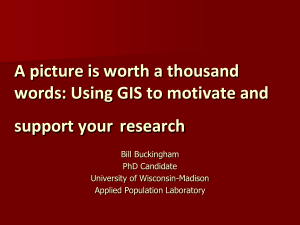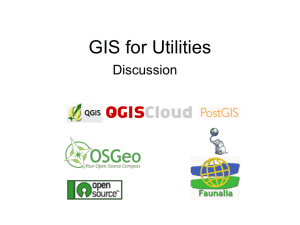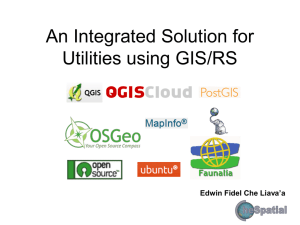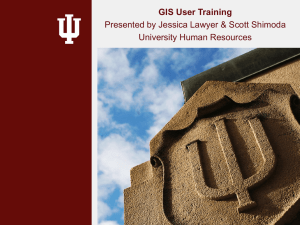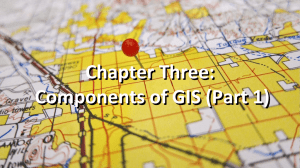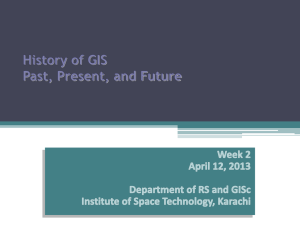What is GIS?
advertisement
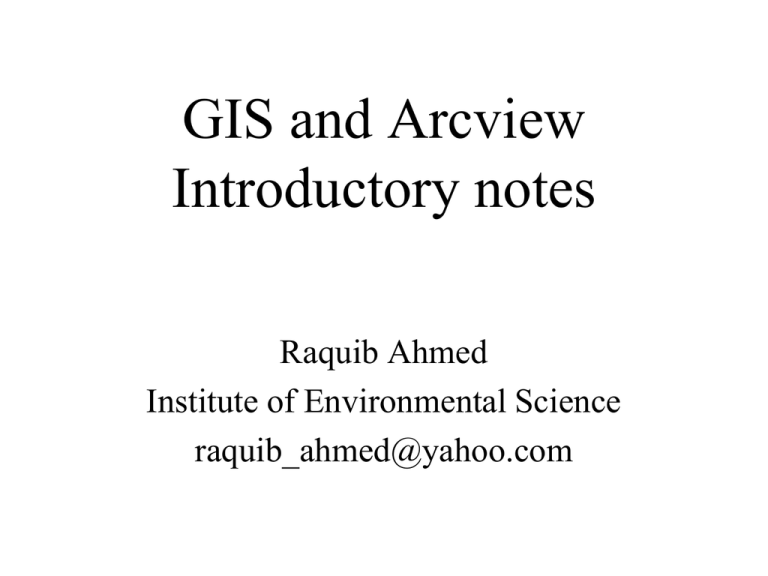
GIS and Arcview Introductory notes Raquib Ahmed Institute of Environmental Science raquib_ahmed@yahoo.com What is GIS? • A technology – hardware & software tools • An information handling strategy • The objective: to improve overall decision making GIS: a formal definition “A system for capturing, storing, checking, integrating, manipulating, analysing and displaying data which are spatially referenced to the Earth. This is normally considered to involve a spatially referenced computer database and appropriate applications software” GIS definition “… a special case of information system where the database consists of observation son spatially distributed features, activities or events, which are definable in space as points, lines or area. A geographic information systems manipulates data about these points, lines and areas to retrieve data for ad hoc queries and analyses” Why is GIS unique? • GIS handles SPATIAL information – Information referenced by its location in space • GIS makes connections between activities based on spatial proximity GIS: historical background This technology has developed from: – Digital cartography and CAD – Data Base Management Systems ID 1 2 3 1 2 X,Y ID ATTRIB 1 2 3 3 CAD System Data Base Management System Digital Mapping Computer Aided Design Photogrammetry GIS Databases Surveying Remote Sensing Cross-disciplinary nature of GIS GIS components Spatial data GIS Computer hardware / software tools Specific applications / decision making objectives What makes data spatial? Grid co-ordinate Placename Latitude / Longitude Postcode Description Distance & bearing Characteristics of spatial data • Location • • • • • • Description: Post Code: Grid Reference: Latitude/Longitude: Elevation: Elepsoid: Rajshahi University, IES 6205 518106.72 168530.37 28.38°E, 88.55°N 17.500m (MSL) WGS84 Characteristics of spatial data Geometry • The shape of a building or county • The course of a river, the route of a road • The shape of the landscape, relief Characteristics of spatial data • Topology Connected to Within Adjacent to North of . . . Within the Royal Borough of Kingston-upon-Thames Opposite the Surrey County Council building North of Surbiton station Adjacent to Penrhyn Road Spatial Data: examples • Socio-economic data – Regional health data – Consumer / lifestyle profiles – Geodemographics • Environmental data – Topographic data – Thematic data, soils, geology Spatial data storage 7,10 • Vector model 5,9 10 9,8 4,7 polygon 8,6 1,6 2,5 5 6,6 line point 5,4 2,2 4,1 5 • Raster model as geometric objects: points, lines, polygons 10 as image files composed of grid-cells (pixels) • Date type – Integer – Real – Byte • File type – ASCII – Binary – Packed Binary Spatial data storage model • important in determining the potential applications of the system • model may also affect the type of analysis work that can be achieved • hybrid approach to storing graphical and attribute information • Attribute information often stored within standard relational database • Graphical information is stored in a proprietary file system – optimised tools for data handling – although non-standard proprietary system will be difficult to integrate with other systems, it will tend to be very efficient at handling large graphics files. Vector data model • advantage of the vector data format: allows precise representation of points, boundaries, and linear features. – useful for analysis tasks that require accurate positioning, – for defining spatial relationship (ie the connectivity and adjacency) between coverage features (topology), important for such purposes as network analysis (for example to find an optimal path between two nodes in a complex transport network) • main disadvantage of vector data is that the boundaries of the resulting map polygons are discrete (enclosed by well-defined boundary lines), whereas in reality the map polygons may represent continuous gradation or gradual change, as in soil maps. Raster data model • good for representing indistinct boundaries – thematic information on soil types, soil moisture, vegetation, ground temperatures • as reconnaissance satellites and aerial surveys use raster-based scanners, the information (ie scanned images) can be directly incorporated into GIS • the higher the grid resolution, the larger the data file is going to be Modelling the real world y 1 1 20 50 1 2 24 45 1 3 52 55 x 2 1 0 45 46 40 ... 000000020 000001000 020010000 000020000 2 2 2 0 1 ... Vector data Land use parcels Raster data Manipulation and analysis • What would happen if . . . A chemical leaked into a river? • Where does . . . The Green Belt exist in relation to the City? • Has . . . Population changed over the last ten years? • Is there a spatial pattern related to . . . Car ownership in our area? Databases & GIS Spatial data • At a simple level a GIS may just form the graphical interface to a database • The majority of GIS applications follow this example MapInfo Linked database table SQL Query Manager Geo-relational Data Models • Linked tables based on the relational model, but storing geographical information such as: – Geometry – Topology – Attributes GIS & Analysis In the context of GIS, analysis is... “Deriving new information from existing data” It is also the manipulation of data to solve a problem e.g. identify all areas within 500m of a lake Increasing use is made of the analytical capabilities of GIS, BUT many GIS projects only use the software to store and manage geographical data Yet analysis often relies on many simple basic GIS techniques Simple Query • The identification of objects and their attributes either by location or attribute query. Buffering • Creation of an area of interest around an object – proximity analysis and environmental impact assessment. Overlays • Layer: A thematic plane of GIS features containing geographically and logically related data • Overlaying involves superimposing two or more map layers to produce a new map layer. • Example: a new genetically engineered variety of wheat grows well in dry environments, with long growing seasons and alkaline soils. Given the availability of data on the length of the growing season, moisture regime and soil alkalinity, where is the best place to plant the wheat? – overlaying (superimposing) several maps showing (separately) water-budget, growing season length, soil pH, sodium content, and so on. The GIS analysis can establish the locations where all the favorable soil conditions coincide, as the places where the wheat will grow best. Country boundary Plus district boundary Plus major rivers Plus major roads Plus railway lines Plus domestic air routes Plus district towns More functions? • • • • • • • Unioning Distance measuring 3D modeling Vertical and horizontal scaleability Web based operation Data center based operation More …… The benefits of GIS include: • Better information management • Higher quality analysis • Ability to carry out “what if?” scenarios • Improve project efficiency GIS Applications • • • • • • Facilities management Marketing and retailing Environmental Transport/vehicle routing Health Insurance and many more . . . Coastal bathymetric measurement Blue NIR Finding the best route to evacuate people during cyclone – A GIS application Important features of cyclone in Bangladesh • In last 30 years, nearly 9,00,000 people died due to disastrous cyclones in Bangladesh • Six out of nine depressions formed in the Bay of Bengal normally cross the coastal belt of Bangladesh almost every year • Thousands of people lose employment due to cyclones • Cyclone preparedness can reduce the loss of life and property Necessity of the study • The coastal region of Bangladesh is densely populated, so risk is higher • The forecasting system in Bangladesh is not so advanced • Can be a part of well organized pre, in time and post cyclone management program • Proposing a new road network for the coastal regions • Overall saving the human lives Statement of the problem • Sudden evacuation of people creates a lot of pressure on existing road network • The travel path should be the shortest • Information regarding the cyclone should be upto-date (mainly regarding the track) • The people don’t have a lot of alternatives to choose from • Coastal region of Bangladesh is crisscrossed by lots of rivers and small canals General statistics of cyclone in Bangladesh Month wise Distribution of the Frequency of cyclones along Different parts of the coast of Bangladesh Month January February March April May June July August September October November December Total Khuln Sundarban coast 0 0 0 0 1 1 0 0 4 5 1 1 13 BarisalPatuakhali Noakhali coast 0 0 0 0 3 2 0 0 0 5 2 2 14 Noakhali Chittagong coast 0 0 0 1 11 5 0 0 2 8 6 0 33 Chittagong Cox's Bazaar coast 0 0 0 3 6 1 0 0 0 5 4 3 22 Total Frequency 0 0 0 4 21 9 0 0 6 23 13 6 82 Frequency 0 0 0 4.88 25.61 10.98 0 0 7.32 28.05 15.85 7.32 100.00 CLASSIFICATION OF CYCLONE DISTURBANCES IN THE BAY OF BENGAL The cyclonic disturbances over the North Indian Ocean as defined in the WMO Tropical Cyclone Operational Plan for the region (TCP-21) are as follows: Types of Disturbances Low Depression Cyclonic storm Severe Cyclonic Storm Severe Cyclonic storm of hurricane intensity In Bangladesh the terms well marked low and deep depression are also used to indicate cyclonic disturbances with wind speed between 17-21 kt (31-40 kph) and 27-33 (51-61 kph) respectively. The Nomenclature of the Tropical disturbances have been changed in the 26th Session of WMO/ESCAP Panel on Tropical cyclone meeting held in Maldives during February, 1999 as follows: Corresponding Knots < 17 kt 17-33 kt 34-47 kt 48-63 kt 64 kt Wind speed ranges Kts Kph >17 17-27 28-33 34-47 48-63 64-119 >120 >31 31-50 51-61 62-88 89-117 118-220 >221 Wind Speed Kph < 31 km 31-61 km 62-88 km 89-117 km >118 km Nomenclature Low Pressure Area Depression Deep Depression Cyclonic Storm Severe Cyclonic Storm Very Severe Cyclonic Storm Super Cyclonic Storm Track of important cyclones in Bangladesh Existing road network of kala Para Thana Roads Extracted road network from 15m resolution ETM+ panchromatic image Roads Land use of Kala para thana General land use Area under settlement Settlement Extracted road network and settlements Settlement Roads Location of cyclone shelters 10 km service area of cyclone shelters Service area Settlement Roads Settlement areas out of 10 km service area Service area analysis results • There are still some settlement areas which are out of 10km service area • As most of the roads are not metalled so it is difficult to count the probable time to reach the shelters from home • Moreover there are lots of rivers which also work as a barrier and lengthen the total time of traveling • Here my suggestion is to build at least a new cyclone shelter in the north western portion so that most of the people could be brought under 10km service area facilities Best route for the people from the surrounding settlement areas who will come to Nilganj cyclone shelter Best route for the people from the surrounding settlement areas who will come to Lata Chapali cyclone shelter Best route for the people from the surrounding settlement areas who will come to Mithaganj cyclone shelter Best route for the people from the surrounding settlement areas who will come to Dhankhali cyclone shelter Arsenic Poisoning- Health Risk & Mitigation Arsenic Arsenic is a highly toxic, naturally occurring grayish- white element used as a poison in pesticides and herbicides. Chemical and Physical Properties Atomic Number 33 Atomic Weight 74.9 Specific Gravity 5.73 Melting Point 817°C at 28atm Boiling Point 613°C (sublimes) Vapour Pressure 1mm Hg at 372°C Sources of occupational exposures to • Arsenic Mining and processing • • • • • • • Wood Preservation Herbicide Pesticide Glass making Hide preservation Food additive: Laboratory procedures Arsenicosis or Arsenic Toxicity • Diffuse Melanosis (First Stage) • Keratosis (Middle Stage) • Cirrhosis ( Third Stage) Arsenic Symptoms Usually it is found that the affects of arsenic pollution become visible on the skin after 8-14 years of taking arsenic contaminated water regularly. · Darkening of skin (Diffuse Melanosis) · Spotted pigmentation (spotted melanosis) · Leucomelanosis (white and black spots side by side · Buccal mucus membrane melanosis (diffuse, patchy, or spotted mela-nosis) · Conjunctival congestion and nonpitting swelling (solid edema) of the feet. · Squamous cell carcinoma Amount of Arsenic in Tube-Well Water Arsenic Concentration on Food • • • • • • • • • Arum- 150mg/Kg. Bean- 5.1 mg/Kg Tomato- 20.1 mg/Kg Papaya- 0.83 mg/Kg-1.1 mg/Kg Cauliflower- 1.8 to 2.7 mg/Kg Cabbage 0.05 to 7.2 mg/Kg Leafy Vegetables- 1.9 to 4.5 mg/Kg Wheat- 1 mg/Kg Rice 5.3 mg/Kg Litho logy of the sample Tube-Well Locations Geology of the Sample Tube-Well Locations Study Area Extraction As the greatest values of arsenic has been observed in Chadpur and Luxmipur districts so these two districts have been selected as study area Study Area Amount of Arsenic in the Tube-Well water in Study Area Arsenic GRID Map of the Study Area Relationship Between Well Depth and Arsenic Concentration Salinity in the soil of the Study Area Salinity in MMHOS/cm Surface Generated Using Arsenic values Relation between Soil Salinity and Arsenic Here the value of regression is -0.1165. Which means that there is no relationship between these two variables Study Area Extraction from the Satellite Images Image of Study Area With Sample Tube-Well Locations FCC Image of the Study Area The FCC image has been used to Extract the water bodies of the Study area. Water Bodies of the Study Area Here the dots represents water bodies. Which plays an important role in the ground water recharge Some Suggestions for Arsenic Prevention • Minimizing the use of ground water sources for irrigation and water supply purposes • Using surface water • Controlling the use of pesticides and fertilizer containing arsenic more than the danger level • Ground water management through recharging ground water reservoirs Environmental assessment Outline: – Introduction – Multi-criteria evaluation (MCE) – Examples Introduction • Principles of environmental protection – land/air/water as common resource – limited: scale and sustainability – essential to make best possible use • identify suitability/appropriateness of use • prevent overuse and degradation • “protect and survive” principle – requires legislation (e.g. EPA, 1990; T&CPA, 1990) Question… • How does one develop an Environmental Assessment using GIS? GIS-based EA • Key stages: – – – – – – problem definition method of impact assessment data collection and processing assessment evaluation reporting Example: wind farms Example: wind farms • Problem? – what impacts? • Method? – what GIS analysis? • Data? – what data and processing required? • Assessment? – application of method(s)? • Evaluation? • Report? GIS approaches • Sieve mapping using: – polygon overlay (Boolean logic) – cartographic modelling – Example uses: • • • • nuclear waste disposal site location highway routing land suitability mapping (e.g. wind farm location) etc. Multi-criteria evaluation • Basic MCE theory: – “Investigate a number of choice possibilities in the light of multiple criteria and conflicting objectives” (Voogd, 1983) – generate rankings of choice alternatives • simple linear programming algorithms • multi-objective optimisation • multi-dimensionality of planning problems Principles of MCE • Methodology – construct evaluation matrix… S11…..SI1 S = . . S1J…..SIJ – standardisation (normalisation) of criterion scores – evaluation of matrix using MCE algorithms MCE techniques • Many techniques – most developed for evaluating small matrices – suitability for large (GIS) matrices? • layers = criterion scores • cells or polygons = choice alternatives – incorporation of levels of importance (weights) – Incorporation of constraint maps – e.g. ideal point analysis, weighted linear summation, hierarchical optimisation, etc. Example: weighted linear summation Map 1 Map 2 Map 3 Standardise User weights Evaluation matrix MCE routine Output Map 4 Conclusions • Few GIS packages provide MCE functionality (e.g. Idrisi32) • Most GIS provide facilities for building MCE analyses (e.g. Arc/Info GRID) • Important method for: – site and route selection – land suitability modelling Thanks
